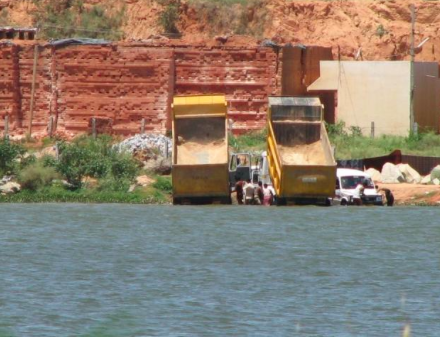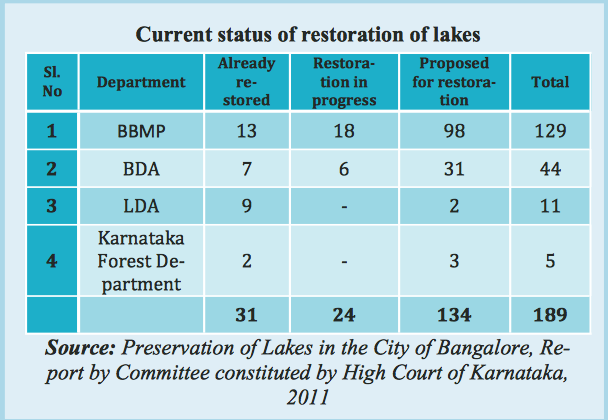Amidst the diminishing number of lakes, from 262 in 1960 to 34 now, in the Silicon Valley lies a forgotten lake.
Anjala Farahath
Toward the South-western part of Bangalore lies Ullal Lake. Contrary to what the name suggests,this lake is far from being one. The lake bed of 31.1 Acres is on its death bed, as the authorities have stalled its restoration and rejuvenation operations.The once flourishing lake is now surrounded by blocked sewage water, dry lake bed,multiple layers of algae, and concrete buildings. The ‘lake’ is merely a fenced land now, that might soon be deserted.
Where is the Lake?
Ullal Lake, in South-western Bangalore is on the brink of transforming into a dry land, while BDA and BBMP are busy playing ‘passing the lake’ game.
How did Ullal lake become a dying wetland of Bangalore?
A combination of negligence and ignorance that comes from continuous garbage dumping, mud lifting or illegal sand mining, dumping of industrial and agricultural debris, and household pollutants like soaps, detergents, shampoos has led to a phased deterioration of Ullal Lake.
According to a report by Environmental Management & Policy Research Institute, Earlier the coconut plantation at the inlet of the Lake, often brought agricultural waste, such as pesticides, fertilizers, etc. during rains the run off. Prior to the fencing of the lake, trucks and vehicles were washed here. In addition to this, people engaged in washing clothes, cattle and themselves. This eventually added to pollution of the lake. The lake area was misused as a space for open defecation and garbage dumping leading to the unhygienic environment and as well as increasing the organic load in the lake. To the west of the lake is a sewage inlet that contaminates the water, and thus results in growth of unsightly scums of algae on the water surface, that in most cases has resulted in fish kills, and can even “kill” a lake by depriving it of oxygen. As it has happened in Bellandur Lake, Varthur Lake, Sarakki Lake, Arekere Lake etc.



The exploitation of wetlands across the city has been a primary reason for their quantitative and qualitative deterioration. While some of the lakes get noticed, and get restored, like Puttenahalli Lake, J P Nagar and Yehalanka, others remain abandoned. Ullal lake is unfortunate enough to belong to the underprivileged category of lakes. The lakes in Bangalore form a chain of hydrological connection through them. The flow of water runs from North to South-East as well as South-West along the natural gradient of the land.This lake belongs to the series of lakes in the Vrishabhavathi valley.

The Vrishabhavati Valley has a treatment plant of 180 MLD (Million litres per day) for treating the wastewater generated in the western part of the city. This treatment plant was established near Nayandanahalli on Mysore Road.
Bangalore runs on an outdated and improper sewage network. Because of an inefficient network of sewers, the storm water drains are flooded and thus carry not only rain water, but also the untreated sewage causing pollution and contamination of lakes.Some of the concerning issues are:
- As the major streams, aka Raja Kamluves are getting encroached, blocked and narrowed down, most lakes are getting dried up. Even the slightest rainfall of 40 mm causes a flood in these areas, since it has no catchment area left.
- Lakes have become the dump yard for all kinds of waste— industrial and household.
- Road widening is done at the cost of lakes, and its area.
- To provide play grounds, or other land uses, lake areas are used.
- Direct connection of sewerage lines into lakes as layouts and apartments have come closer to lake boundaries.
- No under- ground drainage network thereby letting open sewage enters the into nearby lakes through drains that are originally meant to carry rain water.
- Illegal sand mining
So Who owns the Lake?
Everybody…Nobody…
The Civic bodies, Bruhat Bangalore Mahanagara Palike (BBMP) and Bangalore Developmengt Authority (BDA) blame each other for the failure of restoration of the lake. The Bangalore Development Authority (BDA) in 2009-10 had spent Rs 4.49 crore to develop the water body, but soon abandoned it. The lake was fenced, installed with jogging tracks and lights. After this, the lake was handed over to the BBMP, that has found its treasury in negative balance. Therefore the latter, failed to maintain it and the Lake is gradually moving towards becoming a dry land, surrounded by scums of algae.
“The authorities came and cleaned it up, but nothing has happened after that. The lake was cleaned and restored around eight years ago. The lake had water and eventually because of the drains, it got polluted. The authorities need to act and take actions to restore the lake with water and ensure that it is not encroached,” said Venkatesh, a resident of Ullal Residency.
BDA had taken up the responsibility of 12 lakes for restoration and conservation, with the support of Jawaharlal Nehru National Urban Renewal Mission (JNNURM).These wet-lands include Jakkur Lake, Sampigehalli Lake, Rachenahally, Venkateshpura, Ullal, Kommaghatta, Mallathalli, Ramasandra, Thalaghattapura, Konasandra, Sompura and Kothanur lakes.

It has been over a decade since the BDA resolved to bring one MLD of treated water regularly through pipelines from the Sewage Treatment Plant (STP) at the Mallathahalli Lake. But, like most promises, this one remains unfulfilled.
The Lake Committees dodge the ball
The fault lines run deep in the agencies responsible for the maintenance, conservation, restoration and development of the wetlands in Bangalore. The Bangalore Water Supply and Sewage Board (BWSSB), Bruhat Bangalore Mahanagara Palike (BBMP), Bangalore Development Authority (BDA), Bangalore Metropolitan Regional Development Authority (BMRDA),, Lake Development Authority (LDA), Minor Irrigation Department, Taluk,Gram and Zilla Panchayat, and Karnataka Forest Department have roles to play in taking care of lakes in an around the City.
Bangalore Water Supply and Sewage Board (BWSSB) is the supreme care taker of the sewage treatment and Sewage treatment plants. Karnataka State Pollution Control Board (KSPCB) will take up analysis of water twice a year in case of all lakes in the city.LDA will create database of lakes in Bangalore City and host it on web.
Like the saying goes, too many cooks spoil the broth.
As the protocol goes, the BDA develops the lakes and hands it over to BBMP for maintenance and further works (Fencing, Desilting, diversion,pitching embankment, Immersion tank, grill, toilets, waste weir, foot bridge, etc) and the BWSSB collects and treats the sewage that contaminates these wetlands, Although, there are a multiple agencies that are bestowed with legal and administrative powers, little is done to achieve a desirable success rate. There seems to be chaos amongst the Lake authorities itself.

The BDA engineer concerned with Ullal Lake, Devanand, said that the department spent Rs 4. 49 crore in 2009, on Ullal lake’s restoration and it has now handed the lake over to BBMP. On the other hand, BBMP claims that BDA has some unfinished business of laying down pipelines that needs to be completed before BBMP extends its tasks over the lake.
“The unauthorised connections of drains are let into the storm water drains that causes the overflow and blocks the flow of water. This should be stopped and the authorities concerned should look into this matter,” said Sunil, Assistant Executive Engineer, Bangalore West.
“The lake was handed over to BBMP, by the Lake Development Authority(LDA), three years ago. No further work has been initiated by BDA post the transfer. We have finished the job and BBMP is now the custodian,” Sunil added.
On the other hand, BBMP has this to say:
” We are only maintaining the main pathways, not the lake. The lake has been handed over to us by BDA, and although it has been revived, there is no water yet. BDA has laid out pipelines from the nearing malatahalli lake to pump water, but there are some problems in pumping of water, because of which the lake hasn’t received the 2 MLD (million litres per day) of water, everyday. The issue has to be resolved by BDA first.
We have discussed the tender to divert the sewage from the lake but it is still in progress,” said Ravi K.V, BBMP Executive Engineer.
Expert speak
“The BDA engineers have been reviving the lake for many years now. They say that the work is in “progress”, and that has been their stand for all these years. Mostly, because of certain reasons like delay in tender finalization, that has to be undertaken by adhering to the transparency act, and frequent transfers of the officials are the reason for these delays.The BDA has transferred the lake to BBMP now and they should not only maintain the pathways in the lake premises but also, take care of the water levels, the storm water drains, blockages etc,” Mr Yellappa Reddy, an environmentalist said.
Dr. Priyanka Jamwal, Fellow at Centre for Environment and Development ATREE said, “The lakes in Bangalore are contaminated because of the raw sewage that’s allowed to flow into the lakes. This is due to lack of sewage treatment plants. This infrastructure is necessary because the population is increasing. Karnataka State Pollution Control Board in 2006, issued guidelines o residential apartments with 50 units and above, or having a built-up area of 5,000 square meters and above to set up STPs and ETPs (Effluent treatment plants). Since the authorities, buildings, residents etc are not abiding by the law, the loss of lakes persists.”
Alternate Solutions
“Puttenahalli Lake in JP Nagar is one of the best lakes taken care by a resident welfare association and is a model for the other lakes in residential areas. There are a lot of lakes that are better maintained better when it is out of the shadows of the government authorities. Similarly, Ullal Lake should become a matter of concern for the residents and they should take an initiative to solve the issue. They should pressurise the system, or they should create a residents’ lake trust and rejuvenate the lake,” said Vidya Sagar, CEO, Lake Development Authority.
In a first, in May 2011, the BBMP had formally handed over the maintenance of Puttenahalli Lake to Puttenahalli Neighbourhood Lake Improvement Trust (PNLIT),a citizens’ group. BBMP gives no financial assistance and PNLIT meets the expenses through public donations.
According to Environmental Management & Policy Research Institute, a well thought and structured action plan is needed to solve the solution of vanishing lakes, owing to human negligence.
- Lakes should not be diverted for any other purpose like parks, playgrounds, etc.
- Encroachments to be frequently checked and removed
- Untreated sewage to be strictly prohibited
- The present norm of 30m buffer surrounding the legal boundary of lakes is a must to preserve lakes.
- Lakes with a history of migratory birds, flora and fauna should be especially preserved.
- Only a few lakes should be designated to augment water supply, serve as fishing properties and for other uses.
Spot the lake. Or, if that’s too difficult, spot the water maybe?

